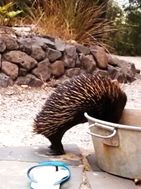Local resident, Adam Fox, observed a group of three Tawny Frogmouths while walking in the National Park. He said that one juvenile was perched on a small dead tree just a few metres off the Nature Walk track at Distillery Creek, and the other two, probably the parents, were in a shrub just behind.
In the same general area of Distillery Creek, Ellinor Campbell saw a Rufous Fantail. She said she loved the way the Fantail flickered along the path in front of her with a really spread-out tail. She noted the behaviour was very different from that of the more common Grey Fantail. They do seem to move through this area during Autumn. Ellinor also reported seeing a raptor here, probably a Brown Goshawk, making frequent shrill squeals, the sound described by Graham Pizzey in his book.
A Bridled Tern has created much interest following sightings along the coast near Barwon Heads, and Bancoora Beach. Bridled Terns are usually found in tropical and subtropical seas and offshore islands. They are rarely found this far south.
Recently, on a warm afternoon, an echidna wandered in to the back garden of Anglesea residents, Des and Judy Clark, where echidnas have been occasional visitors over the years. Judy placed a flat tray of water, which the echidna sipped at, until it walked over to a galvanised washing tub, used for dipping sandy feet after time spent on the beach. The echidna clambered up onto the container and finished drinking even though the water was partially salty and sandy. Visiting daughter, Sarah, photographed the echidna with her smart phone.

Kaye Traynor
Community Support for Hooded Plover – Chapter 2 … Margaret MacDonald
Early on 22 January, a visit to the Hooded Plover site at Moggs Creek, and we could tell by the parent behaviour that something exciting had happened. As we watched the birds’ movements, we were thrilled to see three, fluffy little creatures – less than 7 cm – close to the proud adult birds. Unfortunately by evening it was apparent that there were only two chicks remaining; was the third one just a weak chick, or had it been taken by a Kestrel or some other bird? We will never know the answer to that question.

Hooded Plover chick
Small chick shelters were placed in the area by Great Ocean Road Coastal Committee (GORCC) to help the parents to raise their young chicks. However these excellent parents took control of the situation, at first nestling over the two chicks, and then later using the Silver Spinifex that trailed down on the dunes, and in one particular spot, a clump of dead coastal vegetation where usually one of the parents retreated with the two chicks whenever danger was present.
The chicks are on their own once they have hatched, although they are closely guarded by their alert parents. They need to find their own food, and our two chicks were quite often seen at the water’s edge, or high-tide mark, continually pecking at bits of seaweed, or obviously finding nutrients on the sand. They do not need fresh water. Seabirds have evolved specialised glands that enable them to process sea water, excreting the salt – they have their own desalination system.
The chicks were banded by Birdlife Australia on 4 February. A metal band with a special number was placed around their right foot, but as they were just fourteen days old, no ID could be placed on them at that stage. We were hopeful that they would be flagged before fledging, but due to lack of funding this may not occur. It would have been good to follow these young chicks on the next stage of their life’s journey.
For close on 35 days the parents have protected their chicks from a host of enemies, and now they are just about ready to fly. The parents have been observed keeping adversaries at bay – the two adults moved like streamed-lined jets after a Nankeen Kestrel flew down over the area – the Kestrel took off to sea, and then flew up over the heathlands,. The parents have also warded off Pacific Gulls, Silver Gulls and Magpies. They have also been aggressive towards a hang glider, who landed by mistake in the area, and a surfer who encroached too close to the family. Dogs off-leads have also been a problem, but generally people have respected the signage in the area and have put dogs on leads before walking on this section of shoreline.
Angair members have helped the community and GORCC to monitor the site over the five weekends, encouraging people to give the birds space, and to view them through the GORCC telescope. They have talked to dog owners, who have usually been very co-operative in restraining dogs. People have learnt so much about these rare and threatened creatures that have chosen Moggs Creek to raise their family. We congratulate all who have been involved in the project, and in particular we congratulate the two brave little parents that have taken on the world to protect their family.